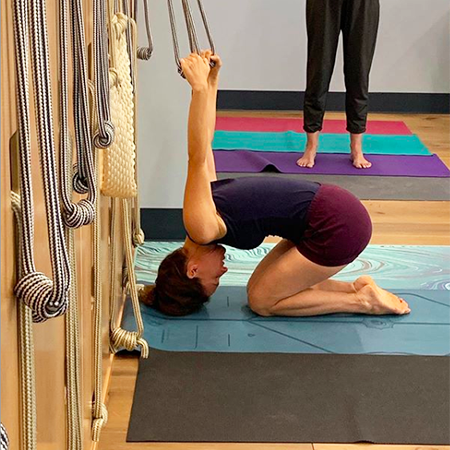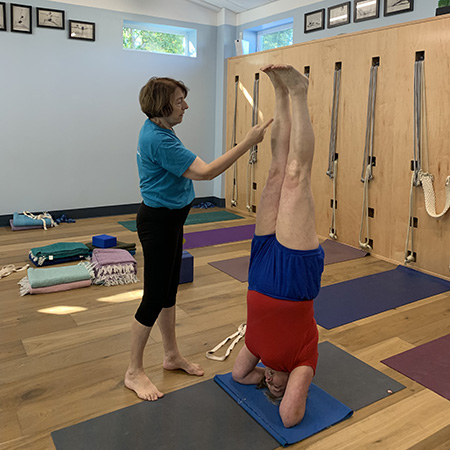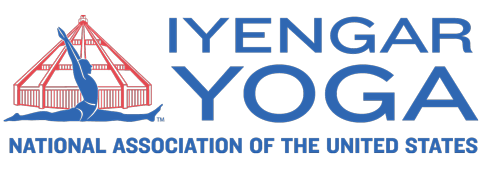Assessment Process
About Assessment
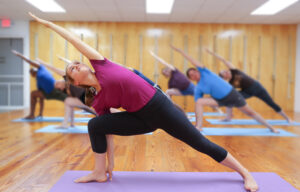
RIMYI provides the structure and guidelines governing Iyengar Yoga certification and assessment.
The IYNAUS Assessment Committee is tasked with the administration of assessments and implementing the RIMYI guidelines. Successful assessments involve many aspects, including training of assessors, exam writing, and venue coordination. While the IYNAUS Assessment Committee administers the assessment process, RIMYI certifies and provides certificates.
Applying for Assessment
Candidates aspiring to assess should work closely with their mentor to understand the requirements for the level they want to apply for. The mentoring teacher is familiar with the process and can offer guidance and support as the aspiring candidate prepares.
Upon acceptance to a mentoring or teacher education program, prospective teachers must join IYNAUS. At the minimum, candidates for assessment must have been members of IYNAUS for at least one year before applying for assessment. For example, if applying for assessment, candidates must have been a member of IYNAUS by May 1 of the previous year.
The Assessment Committee is grateful for your careful attention to the assessment process. Candidates should read the following documents: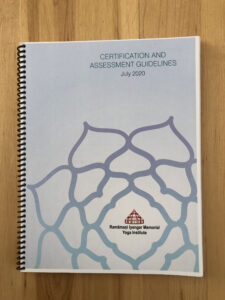
- IYNAUS Assessment Manual: Published by the IYNAUS Assessment Committee, and based upon the RIMYI Certification and Assessment Guidelines, this manual offers advice for teachers, aspiring teachers, and their mentors who are developing the art of teaching Iyengar Yoga. Keen students of Iyengar Yoga will find support for their practice by studying the syllabi from current and past assessment manuals reprinted here. For those considering undertaking the assessment process, this manual also outlines the requirements for each level and an overview of the IYNAUS assessment process.
- RIMYI Certification and Assessment Guidelines: This primary source document provides the requirements to assess and teach each level of certification, the syllabi and required reading, and an outline of the assessment process as envisioned by RIMYI.
RIMYI FAQs: These FAQs provide additional information that should be read and understood.
The Assessment Weekend
Assessors, the Zoom coordinator, students, and others behind the scenes have contributed their time and effort for the weekend assessment. Many are volunteers and the assessment process could not happen without them.
There will typically be three assessors serving during the assessment weekend. If any candidate is a student of one of the assessors, that assessor is allowed to evaluate that candidate.
Candidates accepted for assessment will receive an assigned date and venue for their assessment. A typical assessment weekend is scheduled from Friday morning through Sunday afternoon. Approximately seven weeks prior to the assigned weekend, candidates will receive the written exam. They will have four weeks to complete the take-home exam.
Assessments will begin Friday morning with a general informational meeting for candidates and assessors followed by a technical check with the Zoom coordinator (if online). This is an opportunity for candidates to ask questions about the weekend or the technology.
The assessors and candidates will commence the assessment weekend with a group practice. This is an informal practice, a time for assessors and candidates to connect through practice. Following this practice session, there will be time for discussion. On Friday afternoon, the demonstration component, including the Level 2 individual presentation and inversions practice will take place.
On Saturday and Sunday, the candidates will demonstrate their teaching skills with a group of appropriate-level students. Prior to the weekend, candidates will have received an assigned time for their teaching. Level 1 candidates will have 35 – 45 minutes to teach; a brief situation demonstration follows. Level 2 candidates will have 45 – 55 minutes to teach; the situation presentation will take place right after their teaching. Level 3 candidates will write a sequence appropriate for a two-hour class which they will condense to 75-90 minutes for their assessment class. The Level 3 situation presentation is scheduled for Sunday.
Candidates will be sent feedback from the assessors and an invitation to fill out a web form where they are encouraged to give the Assessment Committee feedback regarding their assessment.
